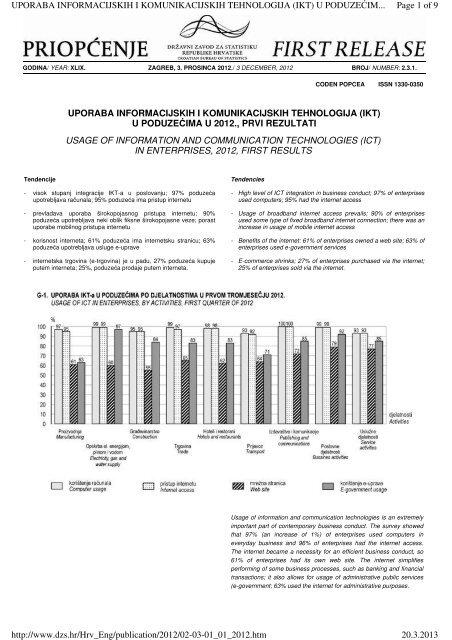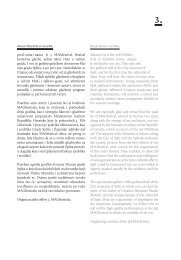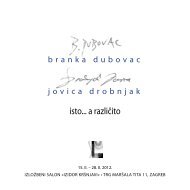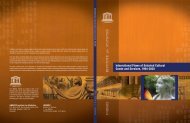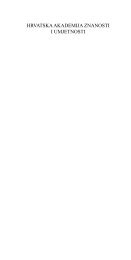ikt - Culturenet
ikt - Culturenet
ikt - Culturenet
You also want an ePaper? Increase the reach of your titles
YUMPU automatically turns print PDFs into web optimized ePapers that Google loves.
UPORABA INFORMACIJSKIH I KOMUNIKACIJSKIH TEHNOLOGIJA (IKT) U PODUZEĆIM...<br />
http://www.dzs.hr/Hrv_Eng/publication/2012/02-03-01_01_2012.htm<br />
Page 1 of 9<br />
20.3.2013<br />
GODINA/ YEAR: XLIX. ZAGREB, 3. PROSINCA 2012./ 3 DECEMBER, 2012 BROJ/ NUMBER: 2.3.1.<br />
CODEN POPCEA ISSN 1330-0350<br />
UPORABA INFORMACIJSKIH I KOMUNIKACIJSKIH TEHNOLOGIJA (IKT)<br />
U PODUZEĆIMA U 2012., PRVI REZULTATI<br />
USAGE OF INFORMATION AND COMMUNICATION TECHNOLOGIES (ICT)<br />
IN ENTERPRISES, 2012, FIRST RESULTS<br />
Tendencije<br />
- visok stupanj integracije IKT-a u poslovanju; 97% poduzeća<br />
upotrebljava računala; 95% poduzeća ima pristup internetu<br />
- prevladava uporaba širokopojasnog pristupa internetu; 90%<br />
poduzeća upotrebljava neki oblik fiksne širokopojasne veze; porast<br />
uporabe mobilnog pristupa internetu<br />
- korisnost interneta; 61% poduzeća ima internetsku stranicu; 63%<br />
poduzeća upotrebljava usluge e-uprave<br />
- internetska trgovina (e-trgovina) je u padu, 27% poduzeća kupuje<br />
putem interneta; 25%, poduzeća prodaje putem interneta.<br />
Tendencies<br />
- High level of ICT integration in business conduct; 97% of enterprises<br />
used computers; 95% had the internet access<br />
- Usage of broadband internet access prevails; 90% of enterprises<br />
used some type of fixed broadband internet connection; there was an<br />
increase in usage of mobile internet access<br />
- Benefits of the internet: 61% of enterprises owned a web site; 63% of<br />
enterprises used e-government services<br />
- E-commerce shrinks; 27% of enterprises purchased via the internet;<br />
25% of enterprises sold via the internet.<br />
Usage of information and communication technologies is an extremely<br />
important part of contemporary business conduct. The survey showed<br />
that 97% (an increase of 1%) of enterprises used computers in<br />
everyday business and 96% of enterprises had the internet access.<br />
The internet became a necessity for an efficient business conduct, so<br />
61% of enterprises had its own web site. The internet simplifies<br />
performing of some business processes, such as banking and financial<br />
transactions; it also allows for usage of administrative public services<br />
(e-government; 63% used the internet for administrative purposes.
UPORABA INFORMACIJSKIH I KOMUNIKACIJSKIH TEHNOLOGIJA (IKT) U PODUZEĆIM...<br />
http://www.dzs.hr/Hrv_Eng/publication/2012/02-03-01_01_2012.htm<br />
Page 2 of 9<br />
20.3.2013
http://www.dzs.hr/Hrv_Eng/publication/2012/02-03-01_01_2012.htm<br />
20.3.2013<br />
UPORABA INFORMACIJSKIH I KOMUNIKACIJSKIH TEHNOLOGIJA (IKT) U PODUZEĆIM...<br />
Uporaba informacijskih i komunikacijskih tehnologija je iznimno važan<br />
dio suvremenog poslovanja. Istraživanje je pokazalo da 97% poduzeća<br />
(porast od 1%) upotrebljava računala u obavljanju svakodnevnih<br />
zadataka, a 96% poduzeća poduzeća ima pristup internetu. Internet je<br />
postao nužan čimbenik učinkovitog poslovanja i 61% poduzeća<br />
poduzeća ima vlastitu internetsku stranicu. Internet pojednostavljuje<br />
obavljanje pojedinih poslovnih procesa poput bankarskih i financijskih<br />
transakcija te omogućuje uporabu administrativnih usluga javne uprave<br />
(e-uprava); 63% poduzeća služi se internetom u administrativne svrhe.<br />
Page 3 of 9<br />
Internet i ostale mrežne tehnologije omogućuju povezivanje poslovnih<br />
jedinica unutar poduzeća i integraciju poslovnih procesa koji doprinose<br />
učinkovitijem poslovanju. Način i brzina prijenosa podataka omogućuju<br />
kvalitetnije poslovanje. Od 96% (porast od 1%) poduzeća koja imaju<br />
pristup internetu, 90% (porast od 6%) ih upotrebljava širokopojasni<br />
fiksni pristup (DSL, kabelski internet, zakupljeni vod). Povećana je<br />
uporaba mobilnog pristupa internetu u poduzećima; 44% (porast od<br />
2%) poduzeća upotrebljava mobilni pristup internetu.<br />
The internet and other network technologies allow for connectivity<br />
between sectors within an enterprise and the integration of business<br />
processes that contribute to more efficient business conduct. The type<br />
and speed of data transfer allow for a higher quality of business<br />
conduct. Out of 96% (an increase of 1%) of enterprises with the internet<br />
access, 90% (an increase of 6%) used fixed broadband connection<br />
(DSL, cable, leased line). There was an increased usage of the mobile<br />
internet, 44% (an increase of 2%) of enterprises used the mobile<br />
internet access.<br />
Internet je uveo promjene u načinu poslovanja omogućivši integriranost<br />
poslovnih procesa na višoj razini. Brzina internetske veze postaje jedan<br />
od važnijih čimbenika u poslovanju. Sve veća dostupnost<br />
širokopojasnog interneta potiče i porast brzine prijenosa podataka. Iz<br />
grafikona je uočljivo da se većina poduzeća još ne koristi vrlo brzim<br />
internetskim vezama. Samo se 5% poduzeća koristi internetskim<br />
vezama koje omogućuju prijenos podataka brzinom većom od 10<br />
Mbps-a.<br />
The usage of the internet caused changes in the ways of business<br />
conduct by allowing for the integration of business processes at a<br />
higher level. Internet connection speed is becoming an important factor<br />
in business conduct. Increasing availability of broadband internet<br />
encourages an increase of data transfer speed. The graph shows that<br />
majority of enterprises still did not use the high speed internet<br />
connections, only 5% of enterprises used internet connections that<br />
enable data transfer speed of over 10 Mbps.
UPORABA INFORMACIJSKIH I KOMUNIKACIJSKIH TEHNOLOGIJA (IKT) U PODUZEĆIM...<br />
http://www.dzs.hr/Hrv_Eng/publication/2012/02-03-01_01_2012.htm<br />
Page 4 of 9<br />
20.3.2013<br />
Uporaba usluga e-uprave omogućuje bolju dostupnost informacijama i<br />
ubrzava rješavanje administrativnih procedura. Gotovo sve usluge su<br />
ostale na razini prošlogodišnjih rezultata. Od nekoliko dostupnih<br />
usluga, 74% (porast od 2%) poduzeća upotrebljava usluge e-uprave za<br />
prikupljanje informacija, 76% upotrebljava usluge za prikupljanje<br />
obrazaca (pad od 2%). Nešto se rjeñe upotrebljavaju usluge poput<br />
povrata ispunjenih obrazaca (71% – porast od 8%) ili rješavanja<br />
administrativnih poslova (60% – porast od 11%). Usluga podnošenja<br />
ponuda za natječaje u elektroničkom obliku zabilježila je manji porast, s<br />
14% na 18%.<br />
The usage of e-government services provides for a better information<br />
accessibility and speeds up a delivery of administrative procedures.<br />
Almost all services remained at the previous-year levels. Out of several<br />
services available, 74% (an increase of 2%) of enterprises used<br />
services to obtain information and 76% to obtain forms (a decrease of<br />
2%). Other services, such as returning filled-in forms (71% – an<br />
increase of 8%) or the treatment of administrative procedures (60% –<br />
an increase of 11%), were somewhat less used. The service of<br />
submitting tender proposals showed an increase in usage, from 14% to<br />
18%.<br />
Integracija poslovnih procesa i komunikacija izmeñu poslovnih<br />
subjekata putem interneta omogućuje učinkovitiju ponudu dobara i<br />
usluga te njihovu kupnju i prodaju na tržištu. Istraživanje je pokazalo da<br />
su internetska kupnja i prodaja u blagom padu. Dobra i usluge putem<br />
interneta kupuje 27% poduzeća (pad od 12%), dok ih 25% (pad od 1%)<br />
nudi na prodaju. Udio e-trgovine u odnosu na konvencionalnu trgovinu<br />
još je uvijek prilično nizak, dok je u većini poduzeća taj udio manji od<br />
10%.<br />
The integration of business processes and communication between<br />
business entities via the internet allow for a more efficient offer of goods<br />
and services and their purchase and sale on the market. The survey<br />
showed that purchases and sales via the internet slightly decreased.<br />
There were 27% (a decrease of 12%) of enterprises that bought<br />
products and services via the internet, while only 25% (a decrease of<br />
1%) of enterprises offered them for sale. The share of e-commerce<br />
compared to conventional commerce was still rather low, in most<br />
enterprises this share was less than 10%.<br />
METODOLOŠKA OBJAŠNJENJA<br />
Svrha statističkog istraživanja<br />
Podaci prikazani u ovom priopćenju jesu procjene dobivene iz<br />
NOTES ON METHODOLOGY<br />
Purpose of the statistical survey<br />
Data shown in this publication are estimates obtained through the IKT-
http://www.dzs.hr/Hrv_Eng/publication/2012/02-03-01_01_2012.htm<br />
20.3.2013<br />
UPORABA INFORMACIJSKIH I KOMUNIKACIJSKIH TEHNOLOGIJA (IKT) U PODUZEĆIM...<br />
istraživanja IKT-POD. To je godišnje istraživanje o uporabi<br />
informacijskih i komunikacijskih tehnologija (IKT) i pruža informacije o<br />
uporabi računala, interneta, elektroničkog poslovanja i ostalih IKT-a u<br />
poduzećima. Podaci su važan izvor za provoñenje politike u području<br />
informacijskog društva u Republici Hrvatskoj i Europskoj uniji.<br />
Page 5 of 9<br />
POD Survey. This is an annual survey on the usage of information and<br />
communication technologies (ICT) and provides information on the<br />
usage of computers, the internet, electronic commerce and other ICTs<br />
in enterprises. The data are an important source for conducting policies<br />
in the field of information society in the Republic of Croatia andin the<br />
European Union.<br />
Svrha statističkog istraživanja<br />
Pravna osnova<br />
Istraživanje IKT-POD provedeno je u okviru smjernica Eurostata tijekom<br />
2012., a provodi se na temelju Zakona o službenoj statistici (NN, br.<br />
103/03. i 75/09.). Provela ga je agencija Ipsos Puls d. o. o. uime<br />
Državnog zavoda za statistiku Republike Hrvatske. Istraživanja su<br />
provedena u svim državama EU-a, dakle podaci su meñunarodno<br />
usporedivi. Meñunarodni podaci dostupni su na e-adresi<br />
http://epp.eurostat.cec.eu.int, Themes Science and Technology Data.<br />
Koncepti i definicije koji se primjenjuju u istraživanju IKT-POD usklañeni<br />
su s EU-ovom Metodologijom za statistike o Informacijskom društvu,<br />
2008.<br />
Promatrane jedinice<br />
Promatrane jedinice jesu poduzeća registrirana na teritoriju Republike<br />
Hrvatske te obavljaju navedene djelatnosti prema klasifikaciji NACE:<br />
Purpose of the statistical survey<br />
Legal framework<br />
The IKT-POD Survey was conducted, according to Eurostat guidelines,<br />
in 2012 on the legal basis of the Official Statistics Act (NN, Nos. 103/03<br />
and 75/09). It was conducted by the Ipsos Puls d.o.o. agency on behalf<br />
of the Croatian Bureau of Statistics. Harmonised surveys were<br />
conducted in all EU Member States, and therefore the data are<br />
internationally comparable. The international data are available on the<br />
following web site address: http://epp.eurostat.cec.eu.int, Themes<br />
Science and Technology Data. Concepts and definitions used in the<br />
IKT-POD Survey are in line with the EU Methodology for Statistics on<br />
the Information Society, 2008.<br />
Observation units<br />
The observation units are enterprises registered on the territory of the<br />
Republic of Croatia for performing the following activities according to<br />
the NACE classification:<br />
Područje C – Prerañivačka industrija C Manufacturing<br />
Područje D, E – Opskrba električnom energijom, plinom i vodom D, E Electricity, gas and water supply<br />
Područje F – Grañevinarstvo; F Construction<br />
Područje G – Trgovina na veliko i na malo; popravak motornih G Wholesale and retail trade, repair of motor vehicles and<br />
vozila i motocikla<br />
motorcycles<br />
Područje H – Prijevoz i skladištenje H Transport and storage<br />
Područje I – Djelatnosti pružanja smještaja te pripreme i<br />
I Accommodation and food service activities<br />
usluživanja hrane<br />
Područje J – Informacije i komunikacije J Information and communications activities<br />
Područje L – Poslovanje nekretninama L Real estate activities<br />
Područje M – Stručne, znanstvene i tehničke djelatnosti<br />
M Professional, scientific and technical activities<br />
(odjeljci 69 – 74)<br />
(divisions 69 – 74)<br />
Područje N – Administrativne i pomoćne uslužne djelatnosti N Administrative and support service activities<br />
Poduzeća su klasificirana i prema broju zaposlenih osoba:<br />
mala (10 – 49 zaposlenih osoba)<br />
srednje velika (50 – 249 zaposlenih osoba)<br />
velika (250 ili više zaposlenih osoba).<br />
Veličina uzorka<br />
Veličina uzorka sastoji se od 4 497 poduzeća.<br />
Okvir uzorka<br />
Osnova za okvir uzorka bio je Poslovni registar Republike Hrvatske<br />
(Fina 2011.).<br />
Metoda prikupljanja podataka<br />
Podaci su prikupljeni putem pošte uporabom tiskanih upitnika.<br />
Poduzeća su mogla slati podatke i putem interneta uporabom online<br />
forme upitnika. Tu opciju upotrebljavalo je 76% poduzeća koja su<br />
sudjelovala u istraživanju.<br />
Referentno razdoblje za glavne varijable bio je siječanj 2012.<br />
Referentno razdoblje za pitanja o internetskoj prodaji i internetskoj<br />
kupnji bila je 2011.<br />
Stupanj neodaziva<br />
Iz ukupne populacije poduzeća (10 622), u uzorak je odabrano 4 497<br />
jedinica.<br />
U istraživanju su sudjelovala 3 012 poduzeća, što znači da je stupanj<br />
odaziva bio 67%, a stupanj prihvatljivosti 98,5%. U obzir nije bilo uzeto<br />
46 izvještaja, tako da je neto uzorak koji se upotrebljavao za tabeliranje i<br />
ponderiranje iznosio 2 966 poduzeća. Stupanj neodaziva bio je 33%.<br />
Ponderacija<br />
RIM weighting metoda (iterative proportional fitting – IPF) upotrijebljena<br />
je za projiciranje na ukupnu populaciju. Ekstrapolacijski ponder<br />
izračunan je za svakog sudionika istraživanja. Metoda izračuna<br />
The enterprises were also classified according to the number of<br />
persons employed as small ones (employing 10 – 49 persons),<br />
medium-sized ones (employing 50 – 249 persons) and large ones<br />
(employing 250 or more persons).<br />
Sample size<br />
The sample consisted of 4 497 enterprises.<br />
Sampling frame<br />
The basis for the sampling frame was the Business Register of the<br />
Republic of Croatia (Fina 2011).<br />
Data collection method<br />
The data were collected by mail using printed questionnaires. The<br />
enterprises could also submit the data via the internet by using the<br />
online form of the questionnaire. That possibility was used by 76% of<br />
the enterprises that took part in the survey.<br />
The reference period for the main variables was January 2012. For the<br />
questions concerning the internet sales and the internet orders, the<br />
reference period was 2011.<br />
Non-response rates<br />
Out of the whole population of enterprises (10 622), there were 4 497<br />
units taken into the sample.<br />
There were 3 012 enterprises that took part in the survey, which means<br />
that the response rate was 67% and the eligibility rate was 98.5%. The<br />
net sample used for tabulation and grossing-up consisted of 2 966<br />
enterprises because 46 reports were not taken into account. The nonresponse<br />
rate was 33%.<br />
Weighting<br />
RIM weighting procedure (iterative proportional fitting – IPF) was<br />
used for the grossing-up. The extrapolation weight was calculated for<br />
each participant of the Survey, while the calculation method included a
http://www.dzs.hr/Hrv_Eng/publication/2012/02-03-01_01_2012.htm<br />
20.3.2013<br />
UPORABA INFORMACIJSKIH I KOMUNIKACIJSKIH TEHNOLOGIJA (IKT) U PODUZEĆIM...<br />
obuhvatila je kategoriju djelatnosti NACE-a, broj zaposlenih, ukupan<br />
promet te ukupan prihod poduzeća.<br />
Page 6 of 9<br />
NACE category, number of employees, of the total turnover and the<br />
total income of an enterprise.<br />
Izvor informacija za ove varijable bio je Poslovni registar Republike<br />
Hrvatske (Fina 2011.). Izračunani ponderi omogućuju računanje<br />
podataka za cjelokupnu populaciju poduzeća. Krajem 2011. ukupan broj<br />
registriranih poduzeća iznosio je 10 622.<br />
Definicije i objašnjenja<br />
ERP (Enterprise Resource Planning) sastoji se od jedne ili više<br />
softverskih aplikacija koje integriraju informacije i procese kroz nekoliko<br />
poslovnih funkcija u poduzeću. U pravilu ERP integrira planiranje,<br />
nabavu, prodaju, promidžbu, odnose s klijentima, računovodstvo i<br />
ljudske resurse. Softver može biti izrañen po narudžbi ili isporučen kao<br />
licencni paket. Licencni paket sadrži softverske komplete kupljene od<br />
proizvoñača koji obuhvaćaju cijelo poduzeće, ali su izrañeni na<br />
modularan način čime omogućuju poduzećima da prilagode sustav<br />
svojim specifičnim aktivnostima primjenjujući samo neke od tih modula.<br />
ERP sustav u pravilu ima ove karakteristike:<br />
The source of information on these variables was the Business<br />
Register of the Republic of Croatia (Fina 2011). The calculated weights<br />
enable the calculation of the data for the whole population of the<br />
enterprises; there were 10 622 enterprises at the end of 2011.<br />
Definitions and explanations<br />
ERP (Enterprise Resource Planning) consists of one or of a set of<br />
software applications that integrate information and processes across<br />
the several business functions of the enterprise. Typically, ERP<br />
integrates planning, procurement, sales, marketing, customer<br />
relationship, finance and human resources. The software can be<br />
delivered either as a customised or a package software. The latter one<br />
is a single-vendor, enterprise wide, software package, but built in a<br />
modular way allowing enterprises to customise the system to their<br />
specific activity implementing only some of those modules. Typically,<br />
the ERP System has the following characteristics:<br />
1. dizajniran je za okruženje klijent-server (tradicionalno ili putem 1. It is designed for a client-server environment (traditional or webbased);<br />
interneta)<br />
2. integrira većinu poslovnih procesa 2. It integrates the majority of business processes;<br />
3. procesira većinu poslovnih transakcija 3. It processes a large majority of business transactions;<br />
4. upotrebljava bazu podataka koja pohranjuje svaki podatak samo 4. It uses a database that stores each piece of data only once;<br />
jedanput<br />
5. omogućuje pristup podacima u stvarnom vremenu. 5 It allows for the access to data in real time.<br />
CRM (Customer Relationship Management) je upravljačka<br />
metodologija koja stavlja klijenta u središte poslovne djelatnosti,<br />
bazirana je na intenzivnoj uporabi informacijskih tehnologija za<br />
prikupljanje, integriranje, obradu i analizu informacija vezanih uz klijente.<br />
Razlikujemo dva modela:<br />
1. operacijski CRM – integriranje u front office poslovne procese koji su<br />
izravno u kontaktu s klijentima<br />
2. analitički CRM – analiza informacija o klijentima koje su dostupne u<br />
poduzeću, uporabom data mininga. Cilj je prikupiti što detaljnije<br />
informacije o klijentima te odgovoriti na njihove potrebe.<br />
E-faktura je faktura u kojoj su svi podaci u digitalnom obliku te može biti<br />
automatski procesirana. Osobina karakteristična za e-fakturu je<br />
automatizacija. E-faktura će biti automatski prenesena na fakturiranje<br />
unutar poduzeća od izdavača fakture ili iz sustava davatelja usluge<br />
izravno u financijske ili slične aplikacije primatelja. Protokol prijenosa<br />
mogu biti XML, EDI ili ostali slični formati.<br />
E-potpis je vrsta elektroničke informacije koja je pridružena ili vezana<br />
uz ugovor ili drugu poruku te upotrebljena kao zakonski ekvivalent za<br />
pisani potpis. Elektronički potpis se često upotrebljava ili u svrhu<br />
stavljanja potpisa u tekst putem jednog ili više elektroničkih načina ili za<br />
kriptografske namjene dodavanjem metoda koje će onemogućiti<br />
krivotvorenje i očuvati integritet dokumenta. Digitalni potpis obično se<br />
izričito odnosi na kriptografski potpis ili na dokumentu ili na nižoj razini<br />
strukture podataka.<br />
Da bi se bilo koji potpis uzeo u obzir, mora imati zakonsku vrijednost,<br />
inače je samo dio komunikacije. Neke internetske stranice i softverski<br />
licencni ugovori (EULA) tvrde da su različite elektroničke radnje<br />
zakonski obvezujući potpisi i instanca elektroničkog potpisa. Npr.<br />
internetska stranica može objaviti da se, kad uopće posjetite stranicu,<br />
morate složiti s odreñenim skupom uvjeta i okolnosti.<br />
Legalni status takvih tvrdnji nije siguran. Elektronički potpis takoñer<br />
može biti digitalan potpis ako upotrebljava kriptografske metode kako bi<br />
osigurao integritet i autentičnost poruka. Zbog uporabe mehanizama za<br />
integritet poruka bilo koja izmjena digitalno potpisanog dokumenta bit će<br />
odmah otkrivena ako se provede test, a upotrijebljen potpis neće biti<br />
prihvaćen kao valjan.<br />
Važno je razumjeti da su kriptografski potpisi mnogo više od samih<br />
tehnika kontrole pogrešaka srodnije checksum algoritmima ili čak visoko<br />
pouzdanim algoritmima za otkrivanje pogrešaka i korekciju algoritma<br />
poput Reed-Solomona. Algoritmi ne mogu osigurati nepromjenjivost<br />
teksta jer cijeli tekst može biti obnovljen po potrebi. Povrh toga protokoli<br />
za integritet teksta ne uključuju korekciju pogrešaka jer bi to moglo<br />
uništiti mogućnost detekcije promjena.<br />
Popularni standardi elektroničkog potpisa uključuju standard OpenPGP<br />
podržan s PGP-om o GnuPG-u i neke S/MIME standarde (dostupne u<br />
CRM (Customer Relationship Management) is a management<br />
methodology that places a customer in the centre of a business activity.<br />
It is based on an intensive use of information technologies to collect,<br />
integrate, process and analyse information related to customers. One<br />
can distinguish between the following two models:<br />
1. Operational CRM – integration of the front office business<br />
processes that are in contact with the customer.<br />
2. Analytical CRM – analysis of the information available in the<br />
enterprise on its customers by using data mining method. This aims<br />
in gathering in-depth knowledge of the customers and to meet their<br />
needs.<br />
E-invoice is an invoice in which all data are in digital format, so it can<br />
be processed automatically. A distinctive feature of an e-invoice is<br />
automation. E-invoice will be automatically transferred to the intercompany<br />
invoicing from the invoice issuer's or service provider’s<br />
system directly into the recipient's financial or other application. The<br />
transmission protocol might be XML, EDI or other similar format.<br />
E-signature is a kind of electronic information attached to or<br />
associated with a contract or another message used as a legal<br />
equivalent to a written signature. Electronic signature is often used to<br />
mean either a signature imputed to a text via one or several electronic<br />
means or for cryptographic purposes by adding non-repudiation or<br />
message integrity features to a document. Digital signature usually<br />
refers specifically to a cryptographic signature, either on a document or<br />
on a lower-level data structure.<br />
For either of them to be considered a signature, they must have a legal<br />
value, otherwise they are just a piece of communication. Some web<br />
pages and software EULAs claim that various electronic actions are<br />
legally binding signatures and so are instances of electronic signature.<br />
For example, a web page might announce that, by accessing the site at<br />
all, you have agreed to a certain set of terms and conditions.<br />
The legal status of such claims is uncertain. An electronic signature can<br />
also be a digital signature if it uses cryptographic methods to assure<br />
both message integrity and authenticity. Because of the use of<br />
message integrity mechanisms, any changes to a digitally signed<br />
document will be readily detectable if tested for, and the attached<br />
signature cannot be taken as valid.<br />
It is important to understand that cryptographic signatures are much<br />
more than an error checking technique akin to checksum algorithms, or<br />
even high reliability error detection and correction algorithms such as<br />
Reed-Solomon. These can offer no assurance that the text has not<br />
been tampered with, as all can be regenerated as needed by a<br />
tamperer. In addition, no message integrity protocols include error<br />
correction, for to do so would destroy the tampering detection feature.<br />
Popular electronic signature standards include the OpenPGP standard<br />
supported by PGP and GnuPG, and some of the S/MIME standards
http://www.dzs.hr/Hrv_Eng/publication/2012/02-03-01_01_2012.htm<br />
20.3.2013<br />
UPORABA INFORMACIJSKIH I KOMUNIKACIJSKIH TEHNOLOGIJA (IKT) U PODUZEĆIM...<br />
Microsoft Outlooku). Sve trenutačne sheme kriptografskih digitalnih<br />
potpisa zahtijevaju da primatelj ima način primanja javnoga ključa<br />
pošiljatelja koji osigurava pripadnost javnoga ključa identitetu pošiljatelja<br />
te da se provode mjere za očuvanje integriteta koje osiguravaju da<br />
autorizacija ili vrijednost javnoga ključa ne mogu biti neopaženo<br />
promijenjeni. Digitalno potpisan tekst može takoñer biti kriptiran radi<br />
zaštite pri prijenosu podataka, ali to nije potrebno ako je cjelokupna<br />
procedura digitalnog potpisa pravilno provedena. Osiguranje privatnosti<br />
bit će vodeći zahtjev.<br />
Page 7 of 9<br />
(available in Microsoft Outlook). All current cryptographic digital<br />
signature schemes require recipient to have a way to obtain the<br />
sender's public key with assurances that the public key and sender<br />
identity belong together and message integrity measures which assure<br />
that neither the authorization nor the value of the public key can be<br />
surreptitiously changed. A digitally signed text may also be encrypted<br />
for protection during transmission, but this is not required when the<br />
digital signature has been properly carried out. Confidentiality<br />
requirements will be the guiding consideration.<br />
SSL/TLS Secure Sockets Layer (SSL) i Transport Layer Security<br />
(TLS) jesu kriptografski protokoli koji omogućuju sigurnu komunikaciju<br />
na internetu. SSL omogućuje krajnju autentičnost i komunikacijsku<br />
privatnost putem interneta upotrebom kriptografije. Kod tipične upotrebe<br />
samo je server identificiran (tj. osiguran je njegov identitet), dok klijent<br />
ostaje neidentificiran; obostrana identifikacija zahtijeva provedbu Public<br />
Key infrastrukture klijentu. Protokoli dopuštaju klijent/server aplikacijama<br />
da komuniciraju na način dizajniran da onemogući prisluškivanje,<br />
mijenjanje i krivotvorenje poruka.<br />
Open Source Softver Free dostupan je unutar open source licence.<br />
Licenca Open Source je licenca s autorskim pravom za računalne<br />
programe koje stavljaju izvorni kod na raspolaganje pod uvjetima koji<br />
omogućuju modificiranje i redistribuciju bez plaćanja originalnom autoru.<br />
Takva licenca može imati dodatna ograničenja kao što su zahtjev da se<br />
sačuva ime autora i izjava o autorskom pravu unutar koda.<br />
S definicijom Open Sourcea povezana je i definicija besplatnog softvera<br />
(Free Software) od Free Software Foundationa koja pokušava obuhvatiti<br />
zahtjeve da licencirani programi budu kvalificirani kao besplatan softver.<br />
Licence koje u praksi zadovoljavaju definiciju Open Sourcea u pravilu<br />
uvijek zadovoljavaju definiciju besplatnog softvera. Od 2005. sve licence<br />
koje zadovoljavaju definiciju besplatnog softvera zadovoljavaju i<br />
definiciju Open Sourcea.<br />
Digitalni proizvodi/usluge jesu svi proizvodi/usluge koji se mogu<br />
naručiti i isporučiti neposredno na računalo putem interneta, npr. glazba,<br />
video, igre, računalni programi, online novine, usluge savjetovanja itd.<br />
xDSL (Digital Subscriber Line) je širokopojasna tehnologija<br />
dizajnirana da poveća frekvencijsko područje za prijenos podataka<br />
dostupan preko standardnih bakrenih telefonskih žica. Uključuje ADSL,<br />
SDSL, HDSL, RADSL, VDSL, DSL-Lite i sl. DSL-linija omogućuje<br />
prijenos podataka i glasa. Dio linije vezan uz prijenos podataka uvijek je<br />
spojen.<br />
ISDN (Integrated Services Digital Network) je digitalna mreža koja<br />
omogućuje istovremeni prijenos podataka, slike i glasa (128 Kb/s).<br />
Modem je ureñaj koji modulira izlazni digitalni signal iz računala ili<br />
ostalih digitalnih ureñaja u analogni signal za konvencionalne bakrene<br />
telefonske linije te demodulira ulazni analogni signal i pretvara ga u<br />
digitalni signal za digitalni ureñaj.<br />
Bežični pristup jest uporaba bežične tehnologije kao što su<br />
radiofrekvencije, infracrvene zrake, mikrovalovi te ostale vrste<br />
elektromagnetskih ili akustičnih valova za zadnju internu poveznicu<br />
izmeñu ureñaja korisnika (računala, pisači itd.) i osnovne mreže (LAN)<br />
unutar radnih prostorija poduzeća. Većinom uključuje tehnologije Wi-fi i<br />
Bluetooth.<br />
E-trgovina su transakcije koje se provode preko mreža računala<br />
baziranih na internetskom protokolu te preko ostalih računalih mreža.<br />
Zaprimanje narudžbi dobara i usluga ostvaruje se putem navedenih<br />
mreža, ali samo plaćanje i konačna isporuka dobara i usluga mogu biti<br />
provedeni online ili offline. Narudžbe zaprimljene telefonom, telefaksom<br />
ili ručno pisanim elektroničkim porukama ne smatraju se e-trgovinom.<br />
E-pošta je elektronički prijenos poruka, uključuje tekst i priloge od<br />
jednog računala do drugog, lociranog u samoj organizaciji ili izvan nje.<br />
To uključuje elektroničku poštu putem interneta ili ostalih računalnih<br />
mreža.<br />
Lokalna računalna mreža (LAN) jest interna računalna mreža koja je<br />
skup od najmanje dva povezana računala upotrebom<br />
telekomunikacijskog sistema sa svrhom komuniciranja i dijeljenja<br />
resursa unutar poduzeća. U pravilu povezuje osobna računala, radne<br />
stanice, pisače, servere i ostale ureñaje. Obično se koristi za razmjenu<br />
internih datoteka izmeñu povezanih korisnika; interna poslovna<br />
SSL/TLS Secure Sockets Layer (SSL) and Transport Layer<br />
Security (TLS) are cryptographic protocols which provide secure<br />
communications on the internet. SSL provides endpoint authentication<br />
and communications privacy over the internet using cryptography. In<br />
typical use, only the server is authenticated (i.e. its identity is ensured)<br />
while the client remains unauthenticated; mutual authentication<br />
requires Public Key Infrastructure deployment to clients. The protocols<br />
allow client/server applications to communicate in a way designed to<br />
prevent eavesdropping, tampering, and message forgery.<br />
Free/Open Source software refers to a computer software under an<br />
open source license. An open-source license is a copyright license for<br />
computer software that makes the source code available under terms<br />
that allow for modification and redistribution without having to pay the<br />
original author. Such licenses may have additional restrictions such as<br />
a requirement to preserve the name of the authors and the copyright<br />
statement within the code.<br />
Related to the Open Source Definition is the Free Software Definition<br />
by the Free Software Foundation, which attempts to capture what is<br />
required for a program license to qualify as free/libre software. In<br />
practice, licenses that meet the Open Source Definition almost always<br />
also meet the Free Software Definition. All licenses reported to meet<br />
the Free Software Definition as of 2005 also meet the Open Source<br />
Definition.<br />
Digital products/services Products/services that can be ordered and<br />
delivered directly to a computer over the internet, e.g. music, videos,<br />
games, computer software, online newspapers, consulting services,<br />
etc.<br />
xDSL (Digital Subscriber Line) Broadband technology designed to<br />
increase bandwidth for data transfer available over standard copper<br />
telephone wires; includes ADSL, SDSL, HDSL, RADSL, VDSL, DSL-<br />
Lite, etc. A DSL line can carry both data and voice signals and the data<br />
part of the line is continuously connected.<br />
ISDN (Integrated Services Digital Network) is a digital network that<br />
enables transmission of voice, picture and data at the same time (128<br />
Kb/s).<br />
Modem is a device that modulates outgoing digital signals from a<br />
computer or other digital device to analogue signals for a conventional<br />
copper telephone line and demodulates the incoming analogue signal<br />
and converts it to a digital signal for the digital device.<br />
Wireless access is the use of wireless technologies such as radiofrequency,<br />
infrared, microwave, or other types of electromagnetic or<br />
acoustic waves, for the last internal link between users devices (such<br />
as computers, printers, etc.) and a LAN backbone line(s) within the<br />
enterprise’s working premises. It includes mainly Wi-fi and Bluetooth<br />
technologies.<br />
E-commerce consists of transactions conducted over the internet<br />
protocol-based networks and over other computer-mediated networks.<br />
Goods and services are ordered via those networks, but the payment<br />
and the ultimate delivery of the good or service may be conducted<br />
online or off-line. Orders received via telephone, facsimile, or manually<br />
typed e-mails are not counted as electronic commerce.<br />
E-mail is an electronic transmission of messages, including text and<br />
attachments, from one computer to another, located either within or<br />
outside the organisation. This includes electronic mail by internet or<br />
other computer networks.<br />
Local Area Network (LAN) is an internal computer network consisting<br />
of a group of at least two computers connected together, using a<br />
telecommunication system for the purpose of communicating and<br />
sharing resources within an enterprise. It typically connects personal<br />
computers, workstations, printers, servers, and other devices. It is used<br />
usually for internal file exchange between connected users; intra
http://www.dzs.hr/Hrv_Eng/publication/2012/02-03-01_01_2012.htm<br />
20.3.2013<br />
UPORABA INFORMACIJSKIH I KOMUNIKACIJSKIH TEHNOLOGIJA (IKT) U PODUZEĆIM...<br />
komunikacija (interna e-pošta, interno internetsko sučelje itd.); dijeljeni<br />
pristup ureñajima (pisači itd.) i ostalim aplikacijama (baze podataka) te<br />
za zajedničke poslovne procese. Mreža je najčešće namijenjena jednoj<br />
zgradi ili usko lociranoj skupini zgrada, omogućuje korisnicima razmjenu<br />
podataka, dijeljenje pisača, upravljanje zajedničkim računalom itd.<br />
Page 8 of 9<br />
business communications (internal e-mail, internal web interface, etc.);<br />
shared access to devices (printers, etc.) and other applications<br />
(databases) or for joint business processes. Network is usually<br />
confined to a single building or closely located group of buildings<br />
allowing users to exchange data, share a printer, master a common<br />
computer, etc.<br />
EDI (Electronic Data Interchange) upotrebljava se za elektroničku<br />
razmjenu podataka, dokumenata i transakcija unutar poduzeća te<br />
izmeñu poduzeća. Razmjena podataka odvija se automatski izmeñu<br />
računalnih sustava izmeñu partnera. Upotrebljavaju se standardni i<br />
kriptirani oblik.<br />
Internet se odnosi na mrežu baziranu na internetskim protokolima:<br />
www, ekstranet putem interneta, EDI putem interneta, internet-ready<br />
mobilni telefoni.<br />
Intranet je interna komunikacijska mreža unutar poduzeća koja se<br />
koristi internetskim protokolom omogućujući komunikaciju unutar<br />
organizacije.<br />
Ekstranet je zatvorena mreža koja koristi internetske protokole kako bi<br />
sigurno dijelila informacije poduzeća s dobavljačima, isporučiteljima,<br />
klijentima ili ostalim poslovnim partnerima. Može poprimiti oblik sigurne<br />
ekstenzije intraneta koji vanjskim korisnicima omogućuje pristup<br />
odreñenim dijelovima intraneta. Može biti i privatni dio internetske<br />
stranice poduzeća kojem je omogućen pristup sadržaju poslovnim<br />
partnerima nakon što se autoriziraju na login-stranici.<br />
Internetska stranica jest mjesto na World Wide Webu identificirano<br />
internetskom adresom. Skupina internetskih datoteka o odreñenom<br />
subjektu uključuje početnu datoteku koja se naziva home page.<br />
Informacije su kodirane posebnim jezicima (HyperText Mark-up<br />
Language (HTML), XML, Java) koji su čitljivi preko internetskih<br />
pretraživača kao što su Mozilla Firefox, Opera ili Microsoft's Internet<br />
Explorer.<br />
RFID (radiofrekvencijska identifikacija) je tehnologija koja<br />
upotrebljava radiofrekvenciju kako bi se razmjenjivale informacije<br />
izmeñu prijenosnih ureñaja/memorija i računala. RFID sustav sastoji se<br />
od labele koja sadrži podatke, antene koja komunicira s labelama te<br />
kontrolerom koji upravlja i nadzire komunikaciju izmeñu antene i<br />
računala. Labele se nalaze na ambalaži ili na proizvodu i mobilna su<br />
baza podataka.<br />
Objavljivanje<br />
Rezultati istraživanja objavljeni su u službenom priopćenju pod nazivom<br />
Informacijsko Društvo – uporaba IKT-a i e-trgovina u poduzećima.<br />
Detaljniji podaci bit će objavljeni na internetskim stranicama Državnog<br />
zavoda za statistiku na e-adresi http://www.dzs.hr.<br />
Ukupni podaci objavljeni su za poduzeća s 10 ili više zaposlenih osoba.<br />
Eurostat objavljuje podatke država EU-a za poduzeća s 10 ili više<br />
zaposlenih osoba. Time je omogućena meñusobna usporedivost<br />
podataka izmeñu Republike Hrvatske i ostalih država Europske unije.<br />
EDI (Electronic Data Interchange) is used for the electronic<br />
interchange of data, documents and orders inside the enterprise and<br />
between the enterprises. Data interchange flows automatically between<br />
the computer systems, between partners, and uses standard and<br />
encrypted form.<br />
The internet relates to the internet protocol-based networks: www,<br />
extranet via the internet, EDI via the internet, internet-ready mobile<br />
phones.<br />
Intranet is an internal company communications network using internet<br />
protocol allowing communications within an organisation.<br />
Extranet is a closed network that uses internet protocols to securely<br />
share enterprise's information with suppliers, vendors, customers or<br />
other businesses partners. It can take the form of a secure extension of<br />
an Intranet that allows external users to access some parts of the<br />
enterprise's Intranet. It can also be a private part of the enterprise's<br />
website, where business partners can navigate after being<br />
authenticated in a login page.<br />
Website is a location on the World Wide Web identified by a Web<br />
address. Collection of Web files on a particular subject that includes a<br />
beginning file called a home page. Information is encoded with specific<br />
languages (Hypertext mark-up language (HTML), XML, Java) readable<br />
with a Web browser, like Mozilla Firefox, Opera, or Microsoft's Internet<br />
Explorer.<br />
RFID (Radio Frequency Identification) is a technology that uses radio<br />
frequency to exchange information between portable devices and<br />
computer. RFID system includes data labels, antennas which<br />
communicate with data labels and a controller device that manages the<br />
communication between antenna and computer. Data labels are stored<br />
on product or packaging and serve as a mobile database.<br />
Publishing<br />
The results of the survey are published in an official first release<br />
entitled Information Society – ICT Usage and E-Commerce in<br />
Enterprises. More detailed data will be published on the web portal of<br />
the Croatian Bureau of Statistics: http://www.dzs.hr<br />
Totals of the data were published for enterprises employing 10 or more<br />
persons. The Eurostat publishes data of the EU countries for<br />
enterprises employing 10 or more persons, which enables<br />
comparability of the data between the Republic of Croatia and other EU<br />
countries.<br />
Kratice<br />
Abbreviaions<br />
EU<br />
Eurostat<br />
Fina<br />
itd.<br />
i sl.<br />
Kb/s<br />
Mbps<br />
NACE<br />
NN<br />
npr.<br />
tj.<br />
Europska unija<br />
Statistički ured Europske unije<br />
Financijska agencija<br />
i tako dalje<br />
i slično<br />
kilobajt u sekundi<br />
megabit u sekundi<br />
Statistička klasifikacija ekonomskih djelatnosti u Europskoj<br />
uniji<br />
Narodne novine<br />
na primjer<br />
to jest<br />
e.g<br />
etc.<br />
EULA<br />
Eurostat<br />
Fina<br />
Kb/s<br />
Mbps<br />
NACE<br />
NN<br />
for example (from Latin: exempli gratia)<br />
and so on (from Latin: et cetera)<br />
End User License Agreement<br />
Statistical Office of the European Communities<br />
Financial Agency<br />
kilobyte per second<br />
megabit per second<br />
Statistical Classification of Economic Activities in the<br />
European Community<br />
Narodne novine, official gazette of the Republic of Croatia<br />
Izdaje i tiska Državni zavod za statistiku Republike Hrvatske, Zagreb, Ilica 3, p. p. 80.<br />
Published and printed by the Croatian Bureau of Statistics, Zagreb, Ilica 3, P. O. B. 80<br />
Telefon/ Phone: +385 (0) 1 4806-111, telefaks/ Fax: +385 (0) 1 4817-666<br />
Odgovara ravnatelj dr. sc. Ivan Kovač.<br />
Person responsible: Dr. Ivan Kovač, PhD., Director General<br />
Priredili: Jasna Pugar i Hrvoje Markuš<br />
Prepared by: Jasna Pugar and Hrvoje Markuš
UPORABA INFORMACIJSKIH I KOMUNIKACIJSKIH TEHNOLOGIJA (IKT) U PODUZEĆIM...<br />
http://www.dzs.hr/Hrv_Eng/publication/2012/02-03-01_01_2012.htm<br />
Page 9 of 9<br />
20.3.2013<br />
MOLIMO KORISNIKE DA PRI KORIŠTENJU PODATAKA NAVEDU IZVOR.<br />
USERS ARE KINDLY REQUESTED TO STATE THE SOURCE<br />
Naklada: 50 primjeraka<br />
50 copies printed<br />
Obavijesti daje Odjel informacija.<br />
Information is available at the Information Department.<br />
Telefon/ Phone: +385 (0) 1 4806-138, 4806-154, 4811-212<br />
Pretplata publikacija/ Subscription: +385 (0) 1 4814-791<br />
Telefaks/ Fax: +385 (0) 1 4806-148, 4806-199<br />
Elektronička pošta/ E-mail: stat.info@dzs.hr<br />
Internetske stranice/ Web site: http://www.dzs.hr<br />
Podaci iz ovog priopćenja objavljuju se i na internetu.<br />
First Release data are also published on the Internet.


